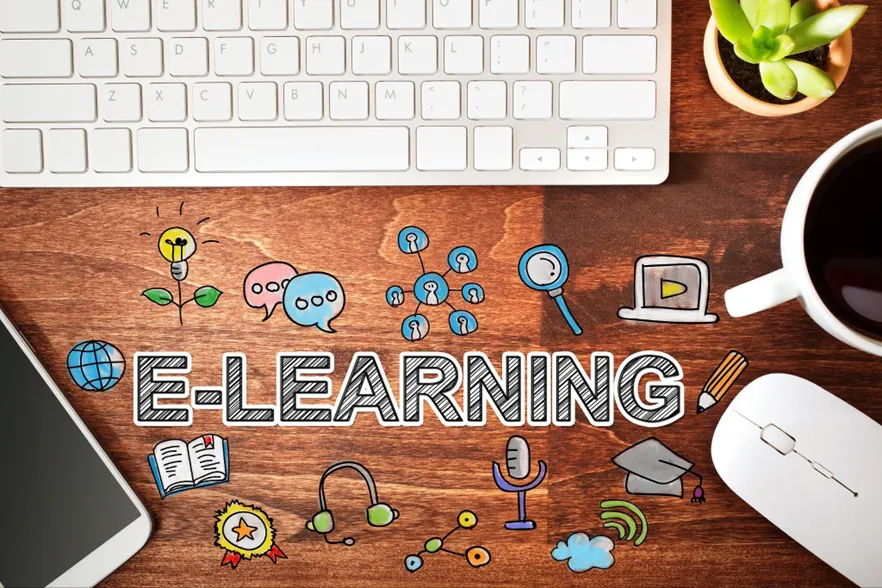
eLearning content creation is essential for transforming traditional educational materials into dynamic, interactive learning experiences.
At our eLearning company, we specialise in converting existing content into engaging eLearning modules.
By incorporating eLearning design best practices, we ensure that every module is not only informative but also captivating for learners.
This blog will guide you through the eLearning content development process, offering practical tips and techniques to make your eLearning content truly engaging and effective.

The Importance of Engaging eLearning Content
Creating engaging eLearning content is crucial for several reasons.
First, it improves learner retention and understanding by presenting information in a more dynamic and interactive way.
Traditional content can be static and uninviting, often leading to disengagement and lower knowledge retention. By converting this content into engaging eLearning formats, learners are more likely to stay interested and remember what they’ve learnt.
Moreover, engaging eLearning content caters to different learning styles. Psychologists have framed the distinct kinds of learners in a range of ways. One popular framework, VARK, developed by Walter Burke Barbe, proposes four main modalities: visual, auditory, reading & writing, and kinaesthetic (movement or touch).
Visual learners benefit from videos and infographics and auditory learners from podcasts and audio recordings. The third kind of learner prefers text-based study while kinaesthetic learners benefit from interactive activities.
By creating content that stimulates all four types of learners, you ensure that all participants can access and comprehend the material effectively.
Finally, engaging eLearning content can be updated and distributed quickly. When new software, processes, legislation, or theories become known, these can be folded into existing courses.
In a time-pressured educational environment, being able to swiftly modify and enhance learning materials is invaluable. This adaptability ensures that content remains relevant and up to date, providing insights your participants will find helpful.
Evaluating Your Content for eLearning Potential
Before transforming traditional content into eLearning modules, it’s crucial to evaluate its potential for eLearning. This can be achieved in a three-stage process:
- Evaluation: Evaluating existing content.
- Prioritising: Determining what to include.
- Simplification: Making the complex more manageable.
Remember that most eLearning occurs without direct supervision, which means you should aim, as much as possible, to make course materials self-explanatory, even at the risk of repetition or over-simplification.
Start by assessing the existing material’s relevance, accuracy, and comprehensiveness.
- Relevance: Does the course content fulfil the educational requirements of the learners in their typical work setting? If not, can it be adapted and updated to create a better fit?
- Accuracy: Are concrete examples, data, practical tips, and case studies accurate, given what the learner would face in a real-world situation?
- Comprehensiveness: Does the content cover the whole topic in sufficient detail. Is a course aimed at beginners too intricate, or is your high-level course insufficiently detailed? Is there material you need to create from scratch?
By asking these questions, you’ll determine if the content is still current and applicable to your learners’ needs.
Next, identify key concepts and learning objectives that must be emphasised. Not all content will be suitable for eLearning, so it’s essential to prioritise information that will benefit most from interactive and multimedia elements.
What are the core competencies the job role requires? These are your must-haves. Anything legally mandatory must be included, of course.
Next, consider what lessons would differentiate an excellent employee from a merely competent one? This type of content is also vital to create an eLearning course of real value.
Lastly, what information would a learner find compelling, surprising, or entertaining? Such material helps keep your courses lively and engaging and will ensure a higher completion rate.
Additionally, consider the complexity of the content.
Some topics may require a more detailed and layered approach to ensure comprehension. Breaking down complex information into smaller, manageable sections can make it easier to transform into eLearning modules.
It’s helpful to provide a notion of the time it might take to complete each module, so that learners can plan their sessions. Remember to allow time for quizzes and other interactive elements which may take two or more passes to complete.
Ask several volunteers to road test your content, and time how long it takes them to finish. Studies have shown that intense concentration can usually be maintained for bursts of around 20 minutes, a realisation which led to the creation of the famous Pomodoro Technique for study (25-minute intervals followed by short breaks).
It may be wise to have 20-25 minutes in mind as your per-module limit.

Designing Custom eLearning Content
Creating bespoke eLearning content involves applying principles of instructional design and engagement to create effective learning experiences. This can be a complex topic, as demonstrated by this rundown of competing instructional design theories, produced by the University of Bath.
Start by defining clear learning objectives. In other words, ask what should my students get out of this course/module/lesson?
These objectives will guide the development process and ensure that the content meets the desired educational learning outcomes.
The SAMR framework is a useful one to bear in mind. SAMR stands for:
1: Substitution: the online element directly substitutes for in-person learning. Taking a quiz online is not dissimilar to completing one in a classroom setting. This is the minimum level of value an online setting can provide.
2: Augmentation: the use of eLearning is mostly a substitute for in-person training but adds elements you might not be able to provide in the classroom (such as allowing students to complete modules in any order).
3: Modification: the use of online content changes the learning process significantly. For instance, you might include elements of gamification, interactive quizzes, and audiovisual content.
4: Redefinition: the boldest type of eLearning might use augmented or virtual reality elements, or a depth of personalisation that cannot be replicated in a classroom.
Incorporate multimedia elements such as videos, animations, and interactive simulations to enhance engagement. These elements not only make the content more interesting but also help in illustrating complex concepts more clearly.
The PBS Space Time YouTube channel, with its over 3 million subscribers is an excellent example of how using an engaging presenter, and appealing animation can explain even the most complex topics in an entertaining, involving manner.
The PBS videos use text, graphics, interviews, and audiovisual content to explain complex ideas, breaking them down into their constituent parts.
Use storytelling techniques to create a narrative around the learning material. Stories can make the content more relatable and memorable, helping learners connect with the material on a deeper level.

Techniques for Effective eLearning Content Development
What are some useful techniques to consider when designing an online course? There are several ideas and strategies worth adopting. Here’s seven to consider:
Microlearning
Breaking down content into small, digestible chunks helps learners absorb information more efficiently and retain it longer. Microlearning is the name most often given to this strategy. If you’ve ever watched a short training film of less than 10 minutes, that’s an example of microlearning.
It’s the same reason we use shorter sentences and paragraph breaks to make text more readable. Microlearning makes complex coursework seem more manageable.
Gamification
Incorporating game-like elements such as points, badges, and leaderboards can motivate learners and increase engagement.
Research has shown that gamification makes learning more fun, by giving us a small dopamine hit along with the rewards of earning a badge, gaining points, or ascending a leaderboard.
Harvard Business School ran a study of 24 office environments comparing gamified learning with more standard methods and found that offices with higher gamified engagement had an increase in securing new clients of 16%.
Interactive Quizzes
These provide immediate feedback and reinforce learning by allowing students to apply what they have learnt. They also ensure that learners cannot move on to a new lesson without understanding the key information in their current module.
Quizzes can take the form of simple questions and answers or can use visual elements and puzzles to shake up the multiple-choice format. Formats such as filling in the blank word in a sentence or matching images with text can add variety and surprise to a quiz.
Scenario-Based Learning
Using real-life scenarios helps learners understand how to apply their knowledge in practical situations. These could be typical (although fictional) scenarios which allow the learner to imagine what an appropriate response to a situation might be.
Sometimes these are presented with a set-up video or description and then a multiple-choice set of solutions. Once the learner chooses a response, they then see how this choice would play out, and they can try all the alternatives one by one.
Scenarios can also take the form of real-world case studies, which can often be more engaging, despite lacking an interactive element.
Video interviews could be broken into set-up and solution elements too, of course, which provides the suspense of wondering how an individual handled a particular scenario, then seeing them explain how they reacted.
Multimedia Integration
Combining text, images, videos, and audio helps cater to different learning styles and keeps the content engaging. Keep video and audio clips as short as possible and focused closely on the topic at hand.
If you use audiovisual elements make sure they have excellent quality images and sound, to maintain the professional sheen of your course. There are numerous companies who produce corporate films, graphics, or animation to help add pzazz to your production.
Adaptive Learning Paths
Personalising the educational experience with Adaptive Learning Paths (based on the learner’s progress and performance) ensures that each participant gets the most out of the eLearning module.
With some topics, you can offer a suite of possible subjects for your learners to explore at will. With other courses, you can tailor elements of the learning path to suit an individual’s specific role or needs.
Mandatory courses will require students to engage with all content, but that doesn’t mean they can’t take modules in whatever order most appeals, so long as they fulfil the assessment requirements.
Social Learning
Incorporating forums, discussion boards, and collaborative projects encourages peer-to-peer learning and community building.
Hybrid courses benefit from in-person interaction but the above methods can provide the next best thing to classroom interaction. Some technical or creative courses can work extremely well with individuals collaborating remotely.
However, even more “people-focused” subjects such as leadership or sales training can benefit from Zoom tutorials, lectures, or discussions.

Interactive and Engaging eLearning Design
Creating interactive elements within eLearning courses is vital for maintaining learner engagement.
Use eLearning content creation software to develop interactive simulations, drag-and-drop activities, and clickable diagrams. These elements allow learners to interact with the content actively, making the learning experience more immersive.
Incorporate branching scenarios where learners can make choices that affect the outcome of the story. This technique not only engages learners but also helps them understand the consequences of their decisions in a risk-free environment.
Additionally, use assessments and feedback loops to keep learners on track. Regular quizzes, interactive exercises, and instant feedback can help reinforce learning and identify areas that need further improvement.
Choosing the Right eLearning Content Creation Software
Selecting the right eLearning content creation software is crucial for effective content development.
Look for software that offers a range of multimedia integration options, such as video, audio, and animation capabilities. This flexibility allows you to create diverse and engaging content.
Ensure that the software is user-friendly and provides templates and themes that can streamline the content creation process. Features like drag-and-drop interfaces and customizable templates can save time and effort.
Additionally, consider software that supports responsive design, ensuring that your eLearning content is accessible on various devices, including smartphones, tablets, and desktops.

Best Practices in eLearning Content Creation
Here are seven simple principles to apply when devising your own eLearning content:
1: Define Clear Objectives
Start with clear and measurable learning objectives to guide the content development process.
2: Keep It Simple
Avoid information overload by focusing on key concepts and breaking down complex information into manageable chunks.
3: Use Multimedia Wisely
Incorporate multimedia elements strategically to enhance understanding without distracting from the core content.
4: Encourage Interaction
Include interactive elements such as quizzes, simulations, and discussion boards to keep learners engaged.
5: Provide Immediate Feedback
Instant feedback helps learners understand their progress and correct mistakes in real-time.
6: Ensure Accessibility
Design content that is accessible to all learners, including those with disabilities, by following accessibility guidelines.
7: Update Regularly
Keep your eLearning content current by regularly reviewing and updating it to reflect the latest information and trends.
Overcoming Challenges in eLearning Content Transformation
The biggest challenges in transforming content for an eLearning format include the following:
1: Identifying Relevant Content
Evaluating and selecting the most pertinent content to convert can be challenging. Focus on material that will benefit most from an interactive approach.
2: Maintaining Engagement
Keeping learners engaged throughout the course can prove difficult. Use varied multimedia and interactive elements to maintain interest.
3: Ensuring Technical Compatibility
Ensure your content works seamlessly across different devices and platforms with thorough testing and technical adjustments where required.
4: Balancing Interactivity and Information
Striking the right balance between interactivity and informational content is crucial. Too much of either can overwhelm or bore learners.
5: Measuring Effectiveness
Track the effectiveness of eLearning content through analytics and feedback. This will help you make necessary adjustments and improvements.

Case Studies: Successful eLearning Transformations
Here are two real-world examples of companies employing eLearning to transform the way they delivered educational content:
BBC Worldwide successfully transformed its training approach by adopting an eLearning solution to enhance digital skills across its global workforce.
Facing the challenge of keeping up with rapid technological advances, BBC Worldwide partnered with CIPD to develop a comprehensive eLearning platform. This platform provided interactive learning modules accessible to employees across different regions.
The initiative led to improved digital literacy, better collaboration, and a more agile workforce, supporting BBC Worldwide’s mission to innovate in a competitive media landscape (CIPD / eLearning Case Studies page 18).
Zurich Life, a leading insurance company, adopted an eLearning strategy to streamline and enhance its compliance training.
By collaborating with eLearning providers, Zurich Life developed engaging, multimedia-rich content that replaced traditional, lengthy training sessions.
This approach not only reduced training time significantly but also increased employee engagement and retention of crucial compliance information.
The eLearning modules were accessible anytime, allowing employees to complete training at their own pace, leading to a more knowledgeable and legislation compliant workforce (CIPD / eLearning Case Studies page 34).
Takeaways
Transforming existing materials into engaging eLearning content provides several benefits, including improved learner retention, adaptability, and accessibility.
By applying the learning strategies discussed, you can create eLearning experiences that are both educational and engaging.
If you’re looking to transform your educational materials, consider our bespoke eLearning services.
We specialise in creating custom eLearning content tailored to your needs. Explore our offerings in eLearning content and our eLearning platform to see how we can help you. Additionally, our virtual training solutions provide interactive and flexible learning opportunities for all types of learners.














